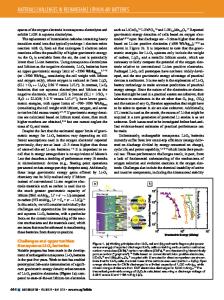Nanohollow Carbon for Rechargeable Batteries: Ongoing Progresses and Challenges
- PDF / 5,036,256 Bytes
- 30 Pages / 595.276 x 790.866 pts Page_size
- 25 Downloads / 355 Views
REVIEW
Cite as Nano-Micro Lett. (2020) 12:183 Received: 31 May 2020 Accepted: 12 August 2020 © The Author(s) 2020
https://doi.org/10.1007/s40820-020-00521-2
Nanohollow Carbon for Rechargeable Batteries: Ongoing Progresses and Challenges Jiangmin Jiang1,2, Guangdi Nie2,3, Ping Nie4, Zhiwei Li1, Zhenghui Pan2, Zongkui Kou2, Hui Dou1, Xiaogang Zhang1 *, John Wang2 *
HIGHLIGHTS • The synthesis strategies of nanohollow carbon materials, including nanospheres, nanopolyhedrons, and nanofibers are summarized. • Nanohollow carbon materials used as electrode materials in several types of rechargeable batteries are reviewed. • The challenges being faced and perspectives of nanohollow carbon materials are discussed.
ABSTRACT Among the various morphologies of carbon-based materials, hollow carbon nanostructures are of particular interest for energy storage. They have been
of rechargeable batteries. The design and synthesis strategies for them and their electrochemical performance in rechargeable batteries, including lithium-ion batter-
ba
rie s
tt e r
ie s
So
m di u
tte
od
on
m
nanopolyhedrons, and nanofibers, in relation to their applications in the main types
ba
that are being made with the nanohollow carbon materials, including nanospheres,
Pot
electrochemical performance. In this overview, we look into the ongoing progresses
Soft t em pla te
and giving rise to high specific capacity, rate capability, cycling ability, and overall
Nanohollow Carbon Materials
h et i e m mfre atesi u Templ as
ing active sites, accelerating electrons/ions transfer, interacting with electrolytes,
Lithiu msu lf
and excellent chemical and mechanical stability, which are beneficial for provid-
d ho et
ratios, controllable pores and pore size distribution, high electrical conductivity,
ies tter ba
ies, owing to their high surface areas in association with the high surface-to-volume
n -io
s Lith erie ium att ard template method b H ur
widely investigated as electrode materials in different types of rechargeable batter-
-i o
n
ies, sodium-ion batteries, potassium-ion batteries, and lithium–sulfur batteries are comprehensively reviewed and discussed, together with the challenges being faced and perspectives for them. KEYWORDS Hollow carbon nanospheres; Nanopolyhedrons and nanofibers; Template synthesis; Rechargeable batteries; Electrochemical performance
* Xiaogang Zhang, [email protected]; John Wang, [email protected] 1 Jiangsu Key Laboratory of Electrochemical Energy Storage Technology, College of Material Science and Engineering, Nanjing University of Aeronautics and Astronautics, Nanjing 210016, People’s Republic of China 2 Department of Materials Science and Engineering, National University of Singapore, Singapore 117574, Singapore 3 Industrial Research Institute of Nonwovens and Technical Textiles, College of Textiles and Clothing, Qingdao University, Qingdao 266071, People’s Republic of China 4 Key Laboratory of Preparation and Application of Environmental Friendly Materials, College of Chemistry, Jil
Data Loading...











